[Home] [Back to Club News] [Back to Library] [To Non Fiction Alphabetized by Author]
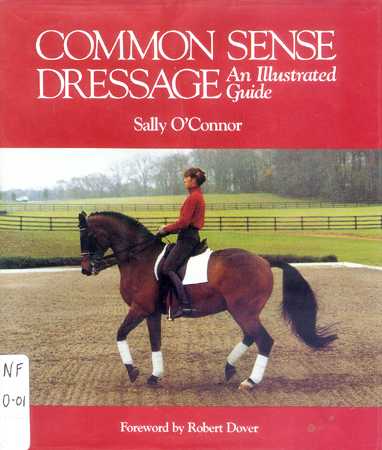
Hardcover, 170 pages, published by The Half Halt Press in 1990
|
Common Sense Dressage presents a practical approach to the training of the horse, building on the foundation of solid basics, and using progressively arranged exercises to develop the horse's full athletic potential - the true goal of dressage training.
The exercises serve as the training steps in the development of the horse from early muscle-building exercises on the lunge and under saddle to more advanced exercises leading go the increased strength and activity of the hindquarters required for advanced movements. There are special exercises to help horses with specific conformation problems. There are even exercises to help the rider improve his or her balance and ability in the saddle, along with a detailed explanation of the often-overlooked role of timing in the rider's aids.
The author's straightforward, conversational style serves to strip away much of the mystery surrounding dressage training, and clarifies many of the more subtle problems and objectives of dressage.
This is a practical book with many illustrations and pictures to help understand what is being explained in the text. |
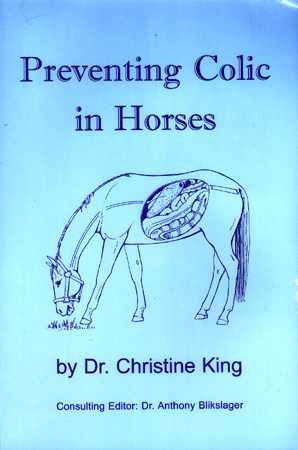
Soft cover, 180 pages, published by The Paper Horse, Inc. in 1999
|
Preventing Colic in Horses is a book for horse owners, trainers, farm/barn managers, veterinary and animal science students - anyone interested in minimizing the incidence and impact of colic in the horses in their care.
Written by an experienced equine veterinarian and edited by a renowned equine surgeon with a special interest in the horse's digestive system, the book combines the latest scientific research with practical information you can begin applying right now.
The four chapters cover the following topics: 1) What is colic?, 2) Risk factors for colic, 3) Strategies for preventing colic, and 4) Managing colic (preventing disasters).
Although this book is intended for the general public of the horse world, it covers the subject in so completely and is so full of technical detail, that it should be of value to even the most advanced student of equine science. It is clearly written and the information is well organized, but because of thorough coverage of all relevant details, it is not an especially easy read. It is, however, well worth the effort. The subject of colic is such an important matter for those who love and care for horses on a daily basis, that the information in this book could literally be a life saver in a critical moment. For the advanced pony clubber who may be thinking of vet school or other advanced studies in animal science, (or who just wants to do very well at the Quiz Rally) it would be ideal. |

Soft cover, 305 pages, published by Howell Book House in 1998
|
Being able to transport your mount to pony club activities is a very great convenience. Sooner or later most pony clubbers and their parents begin to consider acquiring a horse trailer (and a tow vehicle adequate to tow it). Horse trailers come in many different designs and materials from literally scores of different manufacturers. There is very little standardization in the trailer industry and safety and convenience features vary widely from manufacturer to manufacturer. In addition to this, information about tow ratings of cars, trucks and SUV's is hard to come by and some times even harder to interpret. Knowing enough about the subject to make intelligent choices is no easy matter.
Ms. Scheve has extensive experience as a user, dealer, designer and manufacturer of horse trailers. She has written a well organized, clearly written and very comprehensive book on all aspects of buying, operating and maintaining horse trailers safely for both you and your horse. It is simply hard to imagine a more complete, authoritative and useful book on the subject. Whether you are a trailering novice or an old hand, this book will have useful (and in some cases essential) information for you and should be considered required reading. |
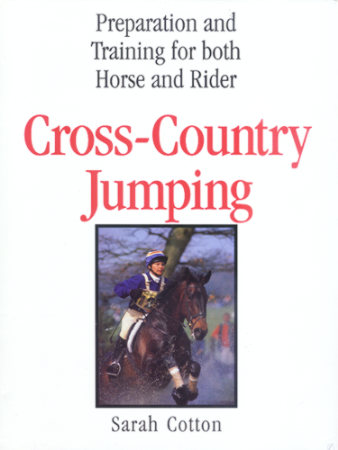
Hardback, 174 pages, published by B. T. Batford Ltd. in 1994
|
This book by international event rider Sarah Cotton aims to teach the amateur rider every aspect of competing successfully at all levels.
She takes the rider through the basics of training on the flat and early jump training, emphasizing the importance of proceeding slowly and logically so that the technique and confidence grow side by side. She also suggests exercises aimed at improving the rider's fitness and establishing the correct riding position - the basis of good cross-country jumping.
She then goes on to examine the many types of fences encountered on cross-country courses, including uprights, parallels, corners, coffins, steps, banks and water fences. In each case, she analyses the approach, the rider's position and technique, and, most importantly, what to do when things go wrong. She also discusses the influence of factors such as the terrain, the weather conditions and the horse and rider's experience.
The final part of the book covers the different aspects of competing, giving advice on preparation, walking and riding the course, and caring for the horse both during and after the competition.
The progressive, practical approach used throughout this book, combined with clear technical drawings and photographs, will allow both experienced riders and those new to the sport to enjoy riding safely and successfully across country. |
A New Video:
Eventing For Newcomers narrated by Gretchen Butts |
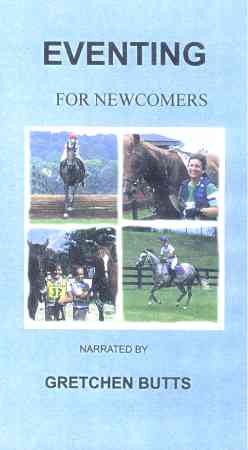 |
Eventing For Newcomers is an action packed video full of information about the equestrian sport of eventing and how to become a competitor. It's a perfect tape for beginning event riders and "would be eventers". The various aspects of the sport are all described using actual footage from Horse Trials and 3-Day Events. Don't miss this exciting overview of the sport of eventing!
Video narrator Gretchen Butts has been eventing since the mid-70's, most recently competing through the Intermediate Two Star Level on Zydeco, who qualified this past year for the USTCA Intermediate Horse Trials Championship. Together with her husband Robert, they run Waredaca, Inc., a riding and recreational facility in central Maryland and have been involved in Eventing for over twenty years. Both their teenage daughters, Stephanie and Devon, are avid riders and active competitors in USPC and USCTA, AHSA events. Gretchen is the former Vice President for Education of the USCTA, active committee member for both the USCTA and AHSA, R event TD, r Event Judge, and organizer of three sanctioned events through the Intermediate level of competition at Waredaca. |
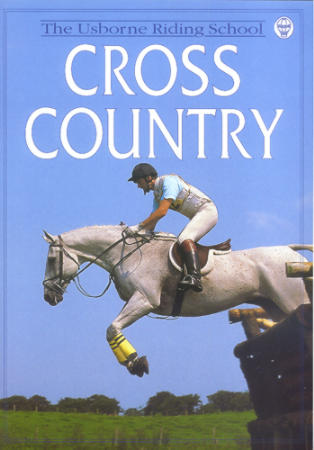 |
This book is the ideal introduction for anyone who wants to enjoy riding and jumping out in the open, Find out how to tackle muddy tracks and steep hills and the best way to approach the obstacles you may meet, from ditches and water to steps and drops. Learn about the equipment you will need and how to get fit for cross-country competitions. The book also looks at the competition itself - how to take part, get the best out of your pony on the big day and take care of him after the event.
Soft back, 31 pages. This book has many pictures and illustrations. It has a lot of basic information about the subject and is especially well suited to the younger reader. |
 |
Almost every horse suffers from lameness at one time or another. Lameness can range from the barely perceptible to potentially career-ending. The condition can arise from a variety of factors: trauma, overexertion, improper care, or poor conformation. Lameness sometimes is easily treated; other times it poses a frustrating challenge to veterinary experts.
In Understanding Equine Lameness, author Les Sellnow defines the condition of lameness in a straightforward, accessible style. You will learn how the horse's front and rear legs are put together and how the horse moves. Understanding Equine Lameness covers the common causes of lameness and how they are diagnosed, treated, and prevented. Original illustrations and photographs enhance the text. Dr. A. Gary Lavin, former president of the American Association of Equine Practitioners, contributes with an insightful foreword. Understanding Equine Lameness is a valuable addition to every horse owner's library.
Soft cover, 119 pages. Published by The Bloodhorse, Inc. in 1998. |
[Top] [Home] [Back to Club News] [Back to Library] [To Non Fiction Alphabetized by Author]
|